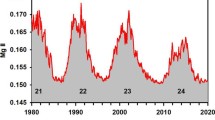Abstract
The observation of celestial light variation data is discontinuous and uneven in the time domain due to weather, equipment, and other factors. And the discontinuous observation data introduce a significant error in the study of the varying light periods. This paper combines the newly developed local mean decomposition(LMD) method and the Lomb–Scargle (LS) algorithm, the most widely used period estimation algorithm for non-uniform time series; a method for analizing the optical variable period of quasars based on the LMD and the LS algorithm is proposed. The principle and the application steps of the method were discussed. The observation data for OJ 287 and 3C 345 at 4.8, 8.0, and 14.5 GHz (radio bands) were collected and analyzed from the University of Michigan UMRAO database. For OJ 287, periods of 12 ± 0.3, 5 ± 0.65, and 2.4 ± 0.01 yr are found in all three bands. There also exist periods of 11 ± 0.9, 5 ± 0.31, and 3 ± 0.28 yr in the three bands for 3C 345. These periods agree with the results of the methods commonly used in some literature. At the same time, some other possible periods are also obtained that can provide references for further research. Results show that estimating the power spectrum is feasible based on LMD+Lomb–Scargle, which provides a new idea for the photoperiod analysis of quasars.















Similar content being viewed by others
References
Blackman, R.B., Tukey, T.W.: The Measurement of Power Spectra. Dover, New York (1958)
Dai, B.Z., Li, X.H., Liu, Z.M., et al.: Mon. Not. R. Astron. Soc. 392, 1181 (2009)
Dong, F.T., Zhang, X.: Acta Phys. Sin. 58(11), 8116-07 (2009)
Edelson, R.A., Krplink, J.H.: Astrophys. J. 646, 659 (1988)
Fan, J.H.: Chin. J. Astron. Astrophys. 5, 213 (2005)
Fan, J.H., Xie, G.Z., Pecontal, E., Pecontal, A., Copin, Y.: Astrophys. J. 507, 173 (1998)
Fan, J.H., Liu, Y., Hua, T.X., et al.: Astron. Astrophys. 462, 547 (2007)
Fan, J.H., Zhang, Y.W., Qian, B.C., et al.: Astrophys. J. Suppl. Ser. 181, 466 (2009)
Fan, J.H., Yuan, Y.H., Wu, H., et al.: Res. Astron. Astrophys. 19, 142 (2019)
Foster, G.: Astron. J. 1889, 1902 (1995)
Foster, G.: Astron. J. 1709, 1729 (1996)
Hocke, K., Mpfer, N.K.: Atmos. Chem. Phys. 9, 4197–4206 (2009)
Jones, R.H.: Appl. Meteorol. 245, 254 (1972)
Jurkevich, I.: Astrophys. Space Sci. 154, 167 (1971)
Kidger, M.R., Beckman, J.E.: Astron. Astrophys. 154, 288 (1986)
Klare, J., Zensus, J.A., Lobanov, A.P., et al.: Astron. Soc. Pac. Conf. 340, 40 (2005)
Liu, F.K., Xie, G.Z., Bai, J.M.: Astron. Astrophys. 295, 1 (1995)
Lomb, N.R.: Astrophys. Space Sci. 39(447), 462 (1976)
Mattox, J.R., Bertsch, D.L., Chiang, J., et al.: Astrophys. J. 410, 609 (1993)
Pei, Z., Fan, J., Yang, J., et al.: Publ. Astron. Soc. Aust. 37, e043 (2020)
Rejkuba, M., Minniti, D., Silva, D.R.: Astron. Astrophys. 406(1), 75–85 (2003)
Roberts, D.H., Joseph, L., Johnw, D.: vol. 968 p. 989 (1987)
Scargle, J.D.: Astrophys. J. 263, 835–885 (1982)
Sillanpàà, A., Haarala, S., Valtonen, M.J., et al.: Astrophys. J. 325, 628 (1988)
Simonetti, J.H., Cordes, J.M., Heeschen, D.S.: Astrophys. J. 46, 59 (1985)
Smith, J.S.: J. R. Soc. Interface 2(5), 443–454 (2005)
Smyth, M.J., Wolstencroft, R.D.: Astrophys. Space Sci. 8, 471 (1970)
Tang, J.: Acta Phys. Sin., 129701-8 (2013)
Tang, J., Zhang, H.J., Pang, Q., et al.: Acta Astron. Sin. 50, 364 (2009)
Valtonen, M.J., Lehto, H.J., Nilsson, K., et al.: Nature 452, 850 (2008)
Webb, J.R., Smith, A.G., Leacock, R.J., et al.: Astron. J. 95, 374 (1988)
Zhang, X., Xie, G.Z., Bai, J.M.: Astron. Astrophys. 330, 469 (1998)
Zheng, Y.G., Kang, S.J., Yang, C.Y., Bai, J.M.: Astrophys. J. 873, 7 (2019)
Acknowledgements
This research has used data from the University of Michigan Radio Astronomy Observatory, which has been supported by the University of Michigan and by a series of grants from the National Science Foundation, most recently AST-0607523, and NASA Fermi grants NNX09AU16G, NNX10AP16G, and NNX11AO13G. The authors wish to acknowledge the assistance and support of all those who contributed to our effort to enhance and develop the described work. This work is partially supported by the National Natural Science Foundation of China (11733001, U1431112, U1531245, 11403006), Natural Science Foundation of Hunan Province (2021JJ30469), and support for the Astrophysics Key Subject of Guangzhou City.
Author information
Authors and Affiliations
Contributions
All co-authors contributed to manuscript revision, data compilation, and figure presentation. All co-authors provided critical review and commentary. The raw data supporting the conclusions of this article will be made available by the author, without undue reservation.
Ethics declarations
Competing Interests
There is no ethical problem in this study.
Additional information
Publisher’s Note
Springer Nature remains neutral with regard to jurisdictional claims in published maps and institutional affiliations.
Rights and permissions
Springer Nature or its licensor holds exclusive rights to this article under a publishing agreement with the author(s) or other rightsholder(s); author self-archiving of the accepted manuscript version of this article is solely governed by the terms of such publishing agreement and applicable law.
About this article
Cite this article
Cai, Jh., Yang, Jh., Tuo, Mx. et al. LMD and Lomb–Scargle power spectrum variability analysis of quasars. Astrophys Space Sci 367, 96 (2022). https://doi.org/10.1007/s10509-022-04124-8
Received:
Accepted:
Published:
DOI: https://doi.org/10.1007/s10509-022-04124-8




